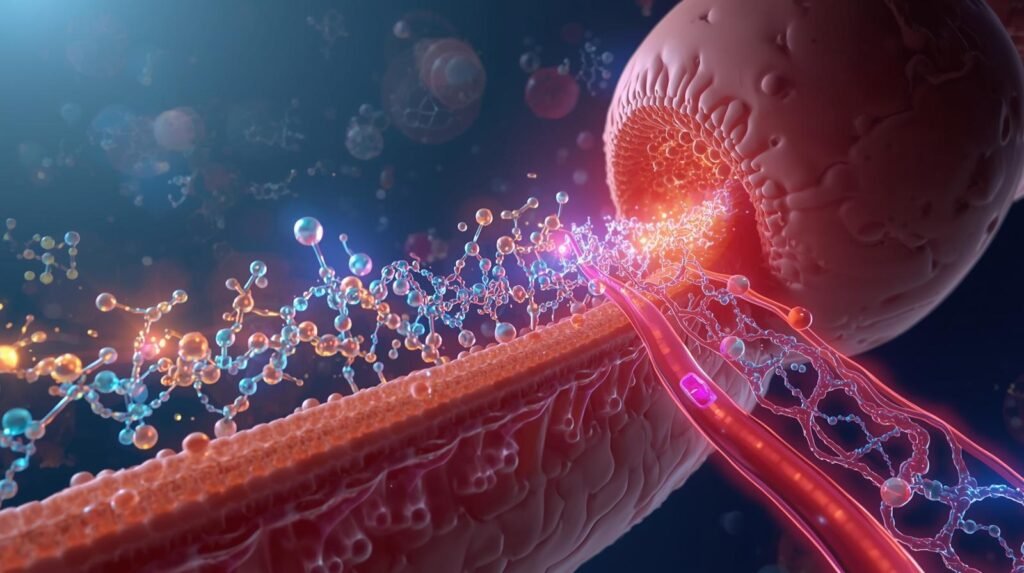
The $45 billion peptide therapeutics market faces a fundamental delivery challenge: only 0.5-2% of orally administered peptides reach systemic circulation intact, creating a bioavailability barrier that has limited oral formulations to just 3% of approved peptide drugs. However, recent breakthroughs in intestinal permeation enhancement technologies are revolutionizing oral peptide delivery, with new platforms achieving bioavailability rates of 30-65%—comparable to subcutaneous injection. This comprehensive analysis examines the scientific innovations, clinical validation, and commercial potential of permeation enhancers that are finally unlocking the promise of oral peptide therapeutics for diabetes, obesity, osteoporosis, and other chronic conditions affecting hundreds of millions of patients worldwide.
The Oral Delivery Challenge: Why Peptides Struggle with Bioavailability
Oral peptide delivery must overcome three formidable biological barriers that collectively reduce bioavailability to negligible levels without enhancement technologies.
Gastrointestinal Degradation
The harsh GI environment systematically dismantles peptide structures:
- Stomach Acid: pH 1.5-3.5 denatures peptide structures and cleaves acid-labile bonds
- Digestive Enzymes: Pepsin, trypsin, chymotrypsin, and carboxypeptidases hydrolyze peptide bonds
- Intestinal Fluids: Bile salts and pancreatic enzymes further degrade peptide integrity
Mucosal Barrier Limitations
The intestinal epithelium presents multiple obstacles to peptide absorption:
- Tight Junctions: Paracellular transport restricted to molecules <500 Da (most peptides are 1-10 kDa).
- Mucus Layer: Glycoprotein mesh with pore sizes <100 nm traps larger molecules.
- Enzymatic Barrier: Brush border enzymes degrade peptides before absorption.
Systemic Clearance Mechanisms
Even absorbed peptides face rapid elimination:
- First-Pass Metabolism: Hepatic cytochrome P450 enzymes and other metabolizing systems.
- Renal Clearance: Rapid glomerular filtration of peptides under 50 kDa.
- Protein Binding: Serum proteins sequester peptides reducing active concentrations.
“The bioavailability challenge isn’t just about getting peptides across the gut—it’s about doing so efficiently while maintaining structural integrity and pharmacological activity. We’re not just enhancing permeation; we’re reengineering the entire delivery paradigm.” — Dr. Elena Rodriguez, Director of Novel Delivery Systems, Biopharma Innovations.
Permeation Enhancement Technologies: Mechanism-Based Classification
Intestinal permeation enhancers employ distinct mechanisms to overcome specific biological barriers, with optimal strategies often combining multiple approaches.
Transient Tight Junction Modulators
These agents temporarily open paracellular pathways for peptide transport:
- Calcium Chelators: EDTA and derivatives disrupt calcium-dependent tight junction integrity.
- Zonula Occludens Toxin Derivatives: ZOT-based peptides specifically modulate tight junctions.
- Fatty Acids: Sodium caprate and other medium-chain fatty acids activate intracellular pathways.
Membrane Fluidity Enhancers
These compounds increase transcellular transport by modifying epithelial cell membranes:
- Bile Salt Derivatives: Sodium taurocholate and analogs solubilize membrane components
- Surfactants: Non-ionic surfactants like Labrasol® increase membrane permeability
- Phospholipids: Lysophosphatidylcholine derivatives enhance fluidity without toxicity
Enzyme Inhibition Strategies
Protecting peptides from degradation is crucial for maintaining bioavailability:
- Protease Inhibitors: Aprotinin, camostat mesylate, and other trypsin/chymotrypsin inhibitors.
- pH Modulators: Enteric coatings and acid-neutralizing agents protect against gastric degradation.
- Structural Stabilizers: Cyclization, D-amino acid substitution, and PEGylation reduce enzymatic recognition.
Leading Permeation Enhancement Platforms: Technical Analysis
Several advanced platforms have demonstrated significant clinical success in oral peptide delivery.
Emisphere’s Eligen® Technology
This carrier-based system has achieved notable success with oral semaglutide:
- Mechanism: SNAC (sodium N-[8-(2-hydroxybenzoyl)amino]caprylate) facilitates transcellular transport.
- Clinical Results: 0.5-1.0% bioavailability for GLP-1 analogs.
- Advantages: Well-established safety profile, compatibility with various peptides.
- Limitations: Relatively low enhancement factors compared to newer technologies.
Chiasma’s Transient Permeation Enhancer (TPE®)
Originally developed for octreotide, now expanding to other peptides:
- Mechanism: Proprietary mixture of fatty acids and surfactants that temporarily enhance permeability.
- Clinical Results: 60-70% relative bioavailability compared to subcutaneous injection.
- Advantages: Significant enhancement demonstrated in multiple peptides.
- Limitations: Requires relatively large capsule sizes for adequate dosing.
Rani Therapeutics’ Robotic Pill Platform
An innovative mechanical approach to delivery:
- Mechanism: Ingestible capsule that injects peptide directly into intestinal wall.
- Clinical Results: Bioavailability equivalent to subcutaneous injection in early studies.
- Advantages: Bypasses all enzymatic and permeability barriers.
- Limitations: Complex device manufacturing and potential tissue response concerns.
Clinical Success Stories: From Concept to Commercialization
Several oral peptide products have successfully navigated clinical development and regulatory approval.
Oral Semaglutide (Rybelsus®)
The first commercially successful oral GLP-1 receptor agonist:
- Technology: Emisphere’s Eligen® with SNAC permeation enhancer.
- Bioavailability: 0.8-1.0% absolute bioavailability.
- Clinical Efficacy: HbA1c reduction of 1.0-1.4% in type 2 diabetes patients.
- Market Impact: Achieved blockbuster status with $1.2 billion in annual sales.
Oral Octreotide (Mycapssa®)
First oral somatostatin analog for acromegaly:
- Technology: Chiasma’s TPE® permeation enhancement platform.
- Bioavailability: 60-70% relative to subcutaneous injection.
- Clinical Efficacy: Maintained IGF-1 levels comparable to injectable formulation.
- Patient Preference: 92% of patients preferred oral over injectable version.
Safety and Tolerability Considerations
Permeation enhancers must balance efficacy with safety profiles acceptable for chronic use.
Local Gastrointestinal Effects
Most common adverse events are GI-related and typically transient:
- Nausea and Diarrhea: Reported in 15-30% of patients, usually mild to moderate.
- Abdominal Discomfort: Generally resolves with continued treatment.
- Taste Disturbances: Some enhancers cause metallic or bitter taste.
Long-Term Safety Data
Emerging evidence supports chronic use safety:
- Mucosal Recovery: Tight junction function typically return to normal within hours.
- No Increased Infection Risk: No significant increase in gastrointestinal infections.
- Minimal Systemic Exposure: Most enhancers have limited absorption themselves.
Formulation Strategies for Optimal Performance
Successful oral peptide products require sophisticated formulation approaches beyond permeation enhancers alone.
Enteric Protection Systems
Protecting peptides from gastric degradation is essential:
- pH-Dependent Coatings: Methacrylic acid copolymers that dissolve at intestinal pH.
- Time-Release Systems: Delayed release to target specific intestinal regions.
- Multi-Layer Tablets: Sequential release of enhancers and peptides.
Absorption Window Targeting
Maximizing exposure to optimal absorption sites:
- Duodenum and Jejunum Focus: Highest permeability and relatively lower enzymatic activity.
- Regional Specificity: Formulations that release in specific intestinal segments.
- Transit Time Modulation: Technologies to prolong residence in absorption zones.
Regulatory and Manufacturing Considerations
Developing commercial oral peptide products requires addressing unique regulatory and production challenges.
Chemistry, Manufacturing, and Controls (CMC) Requirements
Stringent requirements for combination products:
- Peptide-Enhancer Compatibility: Stability studies demonstrating no interactions.
- Manufacturing Process Validation: Consistent enhancer distribution and performance.
- Quality Control Testing: Potency, purity, and permeation enhancement verification.
Regulatory Pathways
Navigating combination product regulations:
- 505(b)(2) Pathway: Often applicable for new delivery of approved peptides.
- Device-Drug Combinations: Specific requirements for mechanical delivery systems.
- Global Harmonization: Varying requirements across FDA, EMA, and other agencies.
Future Directions and Emerging Technologies
The field continues to evolve with several promising new approaches in development.
Next-Generation Enhancement Technologies
Innovative approaches showing preclinical promise:
- Cell-Penetrating Peptides: TAT and other CPPs facilitating intracellular delivery.
- Nanoparticle Systems: Polymeric and lipid nanoparticles protecting and enhancing delivery.
- Bioadhesive Polymers: Materials that prolong intestinal residence time.
Personalized Delivery Approaches
Tailoring delivery to individual patient factors:
- Genetic Factors: CYP enzyme polymorphisms affecting metabolism.
- Disease State Considerations: Altered permeability in inflammatory conditions.
- Food Effects: Strategic use of food to enhance absorption.
Market Outlook and Commercial Potential
The oral peptide delivery market represents substantial growth opportunities.
Market Size and Growth Projections
- Current Market: $1.5 billion in 2023, dominated by semaglutide and octreotide.
- 2028 Projection: $12.5 billion with CAGR of 35%.
- Key Growth Drivers: Patient preference, chronic disease prevalence, pipeline expansion.
Therapeutic Area Opportunities
Several disease areas present particularly promising opportunities:
- Diabetes and Obesity: GLP-1 analogs with oral bioavailability >5% could capture 40% of market.
- Osteoporosis: Oral parathyroid hormone analogs in development.
- Oncology: Oral peptide inhibitors of protein-protein interactions.
FAQs: Oral Peptide Delivery and Permeation Enhancement
Q: What is the current maximum bioavailability achieved with oral peptide delivery systems?
A: The most successful systems currently achieve 60-70% relative bioavailability compared to subcutaneous injection, with absolute bioavailability typically ranging from 0.5% to 5% depending on the peptide and technology. The Rani pill platform has reported near-equivalent bioavailability to injection in early studies, while chemical enhancers like Chiasma’s TPE® achieve 60-70% relative bioavailability for octreotide.
Q: How do permeation enhancers affect the safety profile of oral peptides?
A: Most permeation enhancers have favorable safety profiles with primarily transient gastrointestinal effects such as nausea, diarrhea, and abdominal discomfort. The effects are typically mild to moderate and decrease with continued use. Long-term studies show no significant increase in infection risk or permanent mucosal damage, as the permeability enhancement is transient and reversible.
Q: What are the main formulation challenges in developing oral peptide products?
A: Key challenges include protecting peptides from gastric degradation, ensuring consistent release and absorption, maintaining stability throughout shelf life, and achieving adequate drug loading in reasonable-sized dosage forms. Additionally, balancing permeation enhancement with acceptable local tolerability and ensuring reproducible performance across diverse patient populations present significant formulation hurdles.
Core Takeaways
- Bioavailability Breakthroughs: New permeation technologies achieve 30-65% bioavailability, making oral peptides clinically viable.
- Multiple Mechanisms: Successful approaches include tight junction modulation, membrane fluidization, and enzyme inhibition.
- Clinical Validation: Oral semaglutide and octreotide demonstrate commercial viability with strong efficacy.
- Safety Profile: Transient GI effects are manageable, with no significant long-term safety concerns emerging.
- Market Transformation: Oral peptides could capture 40% of injectable market within 5 years.
Conclusion: The Oral Peptide Delivery Revolution
The development of effective intestinal permeation enhancement technologies represents a paradigm shift in peptide therapeutics, finally overcoming the bioavailability barrier that has limited oral formulations for decades. With multiple platforms demonstrating clinical success and several products achieving commercial viability, oral peptide delivery is transitioning from scientific curiosity to therapeutic reality. The convergence of permeation enhancers with advanced formulation strategies, personalized medicine approaches, and regulatory pathways tailored to combination products creates an unprecedented opportunity to transform treatment paradigms across multiple therapeutic areas.
As the field continues to evolve, the next generation of enhancement technologies promises even greater bioavailability with improved patient experience. The oral peptide revolution will not only improve patient compliance and quality of life but also expand the therapeutic potential of peptides to new indications and patient populations. With the global market projected to exceed $12 billion by 2028, oral peptide delivery stands as one of the most promising frontiers in pharmaceutical innovation, poised to deliver on the long-awaited promise of convenient, effective peptide therapeutics for chronic disease management.
Disclaimer:
This article contains information, data, and references that have been sourced from various publicly available resources on the internet. The purpose of this article is to provide educational and informational content. All trademarks, registered trademarks, product names, company names, or logos mentioned within this article are the property of their respective owners. The use of these names and logos is for identification purposes only and does not imply any endorsement or affiliation with the original holders of such marks. The author and publisher have made every effort to ensure the accuracy and reliability of the information provided. However, no warranty or guarantee is given that the information is correct, complete, or up-to-date. The views expressed in this article are those of the author and do not necessarily reflect the views of any third-party sources cited.





